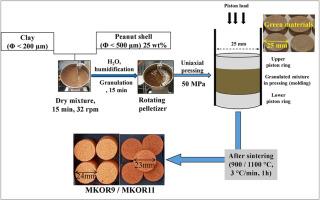莫来石对陶瓷过滤器从布基纳法索井水中去除砷的效果的影响
IF 2.9
Q1 MATERIALS SCIENCE, CERAMICS
引用次数: 0
摘要
近年来,多孔陶瓷因其卓越的技术特性而被广泛研究。其内在的技术特性取决于成型工艺和材料的用途。布基纳法索使用富含熔融氧化物的粘土原料(75%)和废花生壳(25%)制造多孔陶瓷,用于去除井水中的砷。井水分析表明,砷浓度为 39 μg L-1,高于世界卫生组织的标准。多孔陶瓷是由单向压制成型的样品在 900 ℃(MKOR9)或 1100 ℃(MKOR11)烧结后获得的。与 MKOR9 材料不同,MKOR11 材料含有 27% 的莫来石相。MKOR9 和 MKOR11 多孔材料的直径压缩断裂应力大于 0.15 兆帕,这也是文献中对陶瓷过滤器的建议。MKOR11 陶瓷材料的渗透值(53802 升/小时.平方米.巴)远高于 MKOR9(18596 升/小时.平方米.巴),尽管其开放孔隙率(61%)低于 MKOR9 材料(65%)。MKOR9 的去除率为 24%,而 MKOR11 为 95%。MKOR11 过滤器几乎能将砷浓度完全降至世界卫生组织规定的限值以下,而 MKOR9 材料则不然。吸附动力学和热力学参数表明,吸附过程是化学吸附。这项工作表明,MKOR11 陶瓷过滤器具有非常显著的效果,可以生产出来造福偏远地区的居民。本文章由计算机程序翻译,如有差异,请以英文原文为准。

Mullite effect on the ceramic filters effectiveness in the removal of arsenic from borehole water from Burkina Faso
In recent years, porous ceramics have been widely studied because of their excellent technological properties. The intrinsic technological characteristics depend on the forming process and the application for which the materials are intended. A clay raw material (75 mass%) which is rich in melting oxides and waste peanut shells (25 mass%) were used to manufacture porous ceramics for the removal of arsenic from borehole water in Burkina Faso. A borehole water analysis shows a concentration of arsernic of 39 μg L−1 above the WHO standard. The porous ceramics were obtained from samples shaped by unidirectionnal pressing and after sintering at 900 °C (MKOR9) or 1100 °C (MKOR11). Unlike MKOR9 materials, MKOR11 materials consist of 27 % mullite phases. MKOR9 and MKOR11 porous materials presented a diametrical compression stress to rupture greater than 0.15 MPa, as recommended in the literature for ceramic filters. The obtained permeability value of MKOR11 ceramic materials (53,802 L/h.m2.bar) is much higher than that of MKOR9 (18596 L/h m2 bar), although its open porosity (61 %) is lower than that of MKOR9 materials (65 %). The removal rate obtained with MKOR9 is 24 % compared to 95 % for MKOR11. MKOR11 filters almost completely reduce arsenic concentration below the WHO limit values, which is not the case for MKOR9 materials. The adsorption kinetics and thermodynamic parameters showed that the adsorption process is the chemisorption. This work has shown that MKOR11 ceramic filters have a very impressive effectiveness, and they could be manufactured for the benefit of the remote population.
求助全文
通过发布文献求助,成功后即可免费获取论文全文。
去求助
来源期刊

Open Ceramics
Materials Science-Materials Chemistry
CiteScore
4.20
自引率
0.00%
发文量
102
审稿时长
67 days
 求助内容:
求助内容: 应助结果提醒方式:
应助结果提醒方式:


